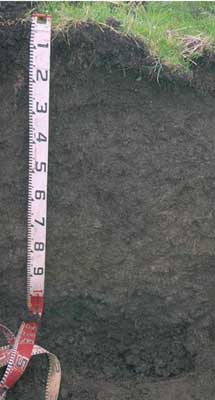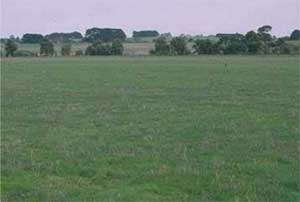SW37
|
| SW37 |  Epiacidic, Epipedal, Black VERTOSOL | |
| Irrewillipe | |||
| Level plain of an associated swamp | |||
| Quaternary sediments overlying Tertiary - Moorabool Viaduct Formation. | |||
| Gentle plain | |||
Horizon | Depth (cm) | Description | ||
A1 | 0-25 | Black (10YR2/1); light clay; strong medium blocky structure; firm consistence (moist); pH 5.5: | ||
B21 | 25-60 | Very dark brown (10YR2/2); medium clay; strong coarse blocky, parting to strong medium blocky structure; very firm consistence (moist); pH 5.5: | ||
B22 | 60-95 | Dark greyish brown (10YR4/2) with dark yellowish brown (10YR4/4) mottles; medium heavy clay; strong fine lenticular, parting to strong very fine lenticular structure; weak consistence (moist); pH 5.8; wavy boundary to: | ||
B23 | 95+ | Very dark grey (10YR3/1), with yellowish brown (10YR5/6) mottles; medium heavy clay; strong fine lenticular, parting to strong very fine lenticular structure; weak consistence (moist); pH 5.5. | ||
| Management considerations | ||||
| Strong texture contrast between the surface soil and the subsoil is a very important soil feature. This can have a major effect by reducing and/or redirecting the internal drainage and restricting root growth beyond the upper horizons. Options include reduced tillage, improving organic matter content and altering the subsoil through artificial drainage (ripping, mole drainage) and/or chemical amelioration (gypsum) to improve structure. Mottled subsoils are common and are an indication of periodic waterlogging, particularly if the mottles are pale (low oxygen conditions). Some brighter mottling may be due to past soil mixing and clay alluviation. Improved drainage, with the application of gypsum for sodic subsoils may be beneficial. Cracking soils vary in their workability depending on their moisture status (highly permeable when dry and impermeable when saturated). These soils are also prone to structure decline particularly when worked wet. They are also generally alkaline with depth and can place stress on roots with their high shrink-swell capabilities. The main priority on these soils is to avoid working when wet (on or below plastic limit). | ||||
Analytical data
Site SW37 | Sample depth | pH | EC | NaCl | Ex Ca | Ex Mg | Ex K | Ex Na | Ex Al | Ex acidity | FC (-10kPa) | PWP (-150kPa) | KS | FS | Z | C | |
Horizon | cm | H2O | CaCl2 | dS/m | % | cmolc/kg | cmolc/kg | cmolc/kg | cmolc/kg | mg/kg | cmolc/kg | % | % | % | % | % | % |
A1 | 0-25 | 5.5 | 4.9 | 0.18 | N/R | 11 | 3.1 | 0.4 | 0.2 | N/R | N/R | 45.9 | 27 | 6 | 14 | 21 | 45 |
B21 | 25-60 | 5.5 | 4.7 | 0.1 | N/R | 3.7 | 5.5 | 0.2 | 0.3 | N/R | N/R | 43.1 | 25.1 | 2 | 10 | 25 | 59 |
B22 | 60-95 | 5.8 | 4.8 | 0.1 | N/R | 2.9 | 7.4 | 0.2 | 0.8 | N/R | N/R | 44.8 | 25.3 | 1 | 7 | 22 | 66 |
B23 | 95+ | 5.5 | 4.6 | 0.13 | N/R | 2.5 | 6.9 | 0.2 | 1.3 | N/R | N/R | 42.7 | 23.3 | 2 | 11 | 21 | 60 |



